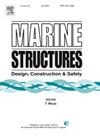动波作用下无底圆筒冰载荷的实验研究
IF 5.1
2区 工程技术
Q1 ENGINEERING, CIVIL
引用次数: 0
摘要
在这项研究中,我们报告了在动力波浪作用下无底圆柱体上冰载荷的综合实验分析结果,并探索了识别、隔离和量化这些载荷的先进方法。为了实现这一目标,我们研究和讨论了各种系统识别技术,如proony方法、动态模态分解(DMD)和协方差驱动的随机子空间识别(SSI-cov),并强调了它们对实验数据的适用性。我们还采用了先进的信号处理方法,包括鲁棒主成分分析(RPCA)和鲁棒局部回归,以分离冰载荷和准周期波载荷。我们的研究结果表明,冰和波浪荷载与浪高呈正相关。当波高不变时,归一化碰撞持续时间随波频增加而增加,与峰值冰荷载的关系不明显。此外,冰荷载比波浪荷载大3 ~ 4倍。这些结果有助于提高我们对波浪-冰-结构相互作用的理解,并为在结冰水域设计弹性离岸结构提供实用的见解。本文章由计算机程序翻译,如有差异,请以英文原文为准。
Ice loads on a bottomless cylinder under dynamic wave action: An experimental study
In this study, we report the results of a comprehensive experimental analysis of ice loads on a bottomless cylinder under dynamic wave action and explore advanced methods to identify, isolate, and quantify these loads. To achieve this, we investigate and discuss various system identification techniques, such as the Prony method, dynamic mode decomposition (DMD), and covariance-driven stochastic subspace identification (SSI-cov), highlighting their applicability to experimental data. We also employ advanced signal processing approaches, including Robust Principal Component Analysis (RPCA) and robust local regression, to separate ice loads from quasi-periodic wave loads. Our findings reveal that ice and wave loads exhibit a positive correlation with wave height. Further, when the wave height remains unchanged, the normalized collision duration increases with wave frequency and shows insignificant dependence on peak ice loads. Additionally, ice loads are found to be times larger than wave loads. These results contribute to advancing our understanding of wave–ice–structure interactions and provide practical insights for designing resilient offshore structures in ice-infested waters.
求助全文
通过发布文献求助,成功后即可免费获取论文全文。
去求助
来源期刊

Marine Structures
工程技术-工程:海洋
CiteScore
8.70
自引率
7.70%
发文量
157
审稿时长
6.4 months
期刊介绍:
This journal aims to provide a medium for presentation and discussion of the latest developments in research, design, fabrication and in-service experience relating to marine structures, i.e., all structures of steel, concrete, light alloy or composite construction having an interface with the sea, including ships, fixed and mobile offshore platforms, submarine and submersibles, pipelines, subsea systems for shallow and deep ocean operations and coastal structures such as piers.
 求助内容:
求助内容: 应助结果提醒方式:
应助结果提醒方式:


